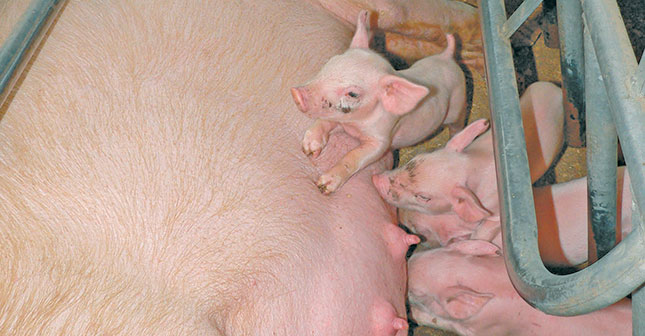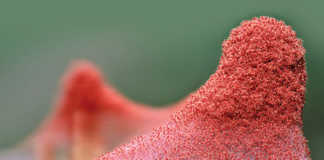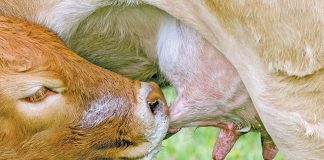
As almost half of the pigs that die on a pig farm do so before they are 14 days old, the farrowing house where the piglets are born and stay for the first 28 to 35 days of their lives must be properly managed.
Important factors
- The farrowing pen must be designed so that the sow can’t lie on top of the piglets.
- Newborn piglets are very sensitive to cold, draughts, wet bedding and floors, and sudden temperature changes. All precautions must be taken to make sure the environment is regulated.
- Make sure that piglets suckle a teat as soon after birth as possible to take in colostrum. This is the first milk produced by the sow which protects piglets against disease.
- If a sow has more piglets than teats, move the piglets to another sow with fewer piglets – but only if the piglets of both sows are born within a few days of each other.
- Sometimes a sow won’t accept her own piglets. If this happens, take the piglets away for a few hours. If she still refuses to accept them, put them with another sow if possible. Slaughter any sow that does not accept her piglets or bites them.
Weaning to slaughter
Good food, good hygiene, good health management and timely treatment are the keys to successful weaners and growers.
- Wean at four to six weeks by removing the sow and leaving the piglets in the farrowing pen for three to five days.
- Clean water and feed, preferably in a self-feeder, must be available to the piglets after weaning.
- Piglets sometimes eat too much for a day or two after weaning, developing diarrhoea. Treat this by feeding less for a few days, but if the diarrhoea continues, treat it with an antibiotic. Mix the antibiotic into the feed or dissolve it in water and admininister through a teat attached to a plastic bottle fastened to the wall or gate. Ask your vet or extension officer to advise you.
- Treat the piglets for internal parasites soon after weaning.
- Keep piglets of the same litter together and move them to the same growth pen seven days after weaning. Piglets from different litters will fight with one another when put in the same pen.
- If you must put pigs from different sows in the same pen, try to group them according to size. Don’t put one or two new pigs in a large group.
- Growing pigs must eat as much of the right feed mixture as possible without becoming too fat.
- Sell growing pigs as porkers when they weigh 60kg to 70kg at between 15 and 18 weeks old, or as baconers when they weigh 86kg to 90kg and are just under six months old.
- Transport pigs to the market when it’s cool – early in the morning or late afternoon.
Specific treatments
Umbilical cord: Disinfect after birth with an iodine solution or any other suitable disinfectant.
Tusk clipping: Piglets have very sharp temporary tusks (teeth) at birth. Use a tusk clipper to clip these to prevent injuries to the teats during suckling. Do not clip the teeth too close to the gums.
Iron injections: Piglets reared outside roll about in soil or mud where they ‘pick up’ iron. For piglets reared on concrete floors, the sow’s milk has insufficient iron and they need iron injections at three to seven days to prevent them from becoming anaemic, with consequent poor appetite and loss of growth.
Hand-rearing pigs
If there is no foster-sow, rejected piglets can be hand-reared using one of the following two milk mixtures:
- 2,5l fresh cow’s milk, 150ml fresh cream, 125ml glucose, 1 beaten egg.
- 4,5l fresh cow’s milk and 0,5l cream.
Feed the piglets small quantities every two to three hours. Start with 50ml at a time and make sure each piglet takes in 350ml a day. Gradually increase the amount to about 100ml at a time so that the piglets get 750ml at three weeks.
Give creep meal in a shallow dish or on the floor from two weeks onwards to encourage the piglets to eat meal as soon as possible. Fresh, clean water must always be available and piglets should be encouraged to drink water as soon as possible.
Dealing with tail biting
Cold, draughts, concrete floors without bedding, not enough eating space and poor ventilation all cause stress in pigs which can lead to them biting each other’s tails.
Pigs with injured tails grow slower and may even die if the injuries are severe. Remove them from the pen, disinfect the wounds and treat them with an antibiotic.
Sources: Farming with Pigs (Compiled by the Western Cape department of agriculture), Guide to Small-Scale Pig Farming by EH Kemm (department of agriculture); the South African Pork Producers’ Association (www.sapork.com).












